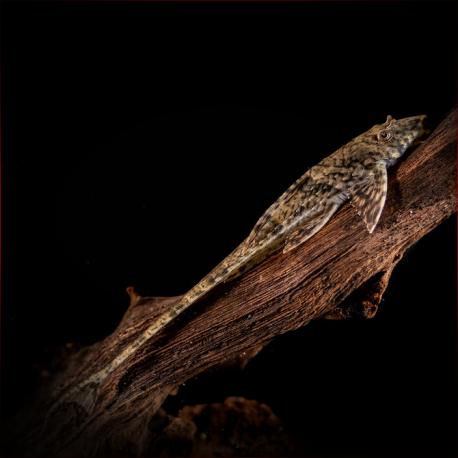More info
Datasheet
| Minimum Tank Size | 81 litres / 21.40 US gallons |
| Maximum Size | 15.0cm / 5.91inches |
| Temperature | 24°C / 75.20°F - 29°C / 84.20°F |
| Hardness | 2-15ºdH |
| pH | 6.0-7.4 |
General Description
One of the most common species sold as 'whiptail catfish,' R. eigenmanni is an excellent choice for beginners in the realm of Loricariids and catfish breeding. While not the most active fish, it is not shy when settled with suitable tankmates. This species has a somewhat confusing taxonomic history, originally classified under Loricaria before moving to Rineloricaria and even a brief stint in the Hemiloricaria genus. Currently, it is considered a member of Rineloricaria, although references to Hemiloricaria still persist, adding to the taxonomic complexity.
Aquarium Setup
For R. eigenmanni, a biotope setup often includes sand with dried leaves scattered over the substrate, together with twisted branches, rounded stones, rock or wood caves, and lengths of PVC piping for potential spawning sites. This species can also thrive in well-planted tanks, appreciating subdued lighting conditions and caves for shelter. Detailed water condition requirements include a pH range of 6.0-7.4, water hardness of 2-15 degrees GH, and a temperature range of 24-29°C (see table).
Behaviour
Regarded as one of the most peaceful catfish types, the Common Whiptail Catfish can coexist harmoniously with various species. To maintain its tranquility, it is best paired with non-aggressive tankmates like small characins, Apistogramma, Corydoras, and other gentle Loricariids. This species is not territorial apart from during spawning, suggesting it is ideal for group settings within the aquarium environment.
Feeding and Diet
In their natural habitat, R. eigenmanni feeds on aufwuchs and small aquatic crustaceans. In captivity, they showcase an omnivorous appetite, enjoying sinking dried foods, vegetable matter such as blanched spinach, courgette, and kale, along with live or frozen options like bloodworms or daphnia.
Reproduction & Dimorphism
Breeding these catfish is achievable with proper conditions and nutrition. The process involves a male selecting and cleaning a cave for egg deposition by a female, after which he fertilizes and guards the eggs. The fry, once hatched, should be fed nutrient-rich green foods and the hatching process can be replicated by conducting large water changes with cooler water, mimicking rainy season influxes.
Habitat and Distribution
R. eigenmanni is primarily found in Colombia and Venezuela, residing in sandy environments covered with leaf litter in both clear and whitewater habitats. Whitewater habitats are distinguished by a high concentration of dissolved sediment as opposed to rapid-flowing water sources.

